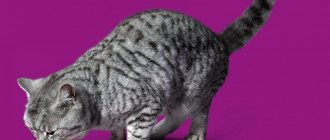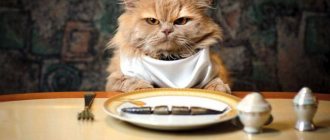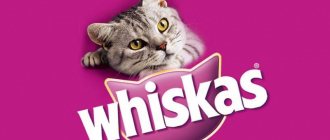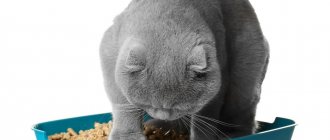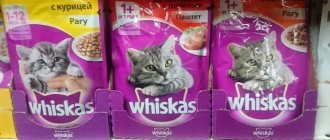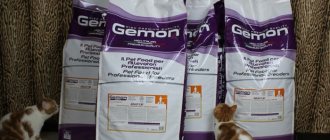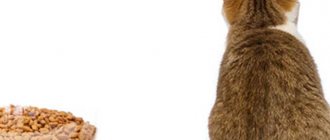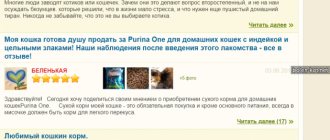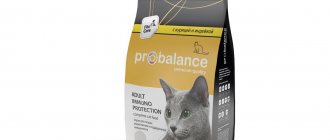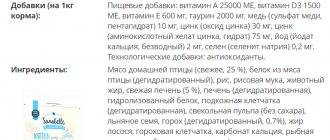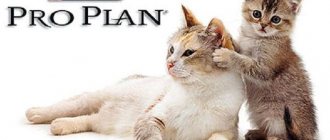Manufacturer
The manufacturer of Whiskas feed is MARS. The brand first appeared in 1958 in the UK, quickly became popular, and has been producing animal food for more than 60 years. The management does not skimp on advertising, over all this time it has developed several types of both dry and wet food, and is opening more and more factories in different parts of the world (including in Russia: in Rostov-on-Don and in the Moscow region).
Feed was first brought to Russia from Germany in 1992, and 2 years later the first production was opened in the Stupinsky district of the Moscow region. In 2000, spiders appeared on the market.
The company has been engaged in charitable activities for a long time. In addition to helping homeless animals in shelters, the company helps implement projects in the field of pet nutrition.
Feed overview
Whiskas cat food belongs to the economy class. It is produced by Mars in dry and wet versions. In addition to this food, the brand produces the following products for cats and dogs: KiteKat, Sheba, Perfect Fit, Royal Canin, Chappi, Pedigree, Cesar. More detailed information about the products can be obtained on the official website of the manufacturer whiskas.ru.
“Would your pussy buy Whiskas?” — the main slogan of the brand is known even to those who do not have a pet. People enthusiastically buy these products, citing their pet’s excellent appetite. Despite the fact that the manufacturer claims that the diet is balanced, it is not recommended to feed the animal this food daily.
Before making a decision to purchase Whiskas food, study the composition analysis. Do not be fooled by the tempting inscription on the packaging, where it is written that the food consists of 80% meat ingredients, this is not so. By buying low-quality food, you save on your pet's health.
Features of Whiskas food for cats:
- The range contains food for all ages, from kittens from two months of age to older pets;
- There is a preventive line that is relevant for solving health problems;
- There is food for sterilized cats and neutered cats;
- Dry formulas are packaged in bags or boxes, depending on volume.
Advantages and disadvantages of Whiskas cat food
The products are on the shelves of any supermarket
Low cost
The manufacturer does not indicate the percentage of ingredients in the composition
The name of the plant components is not specified
There is a dye (due to it you can see granules of different colors)
Availability of flavoring additives and flavor enhancers
Flour is used instead of fresh meat
Low content of meat ingredients
Not recommended as a daily diet
Feed class
Whiskas is an economy class cat food. In the first place in the list of ingredients are cereals, corn, and sometimes they even write “products of plant origin,” without specifying what is hidden under this. Plant ingredients are the main source of protein in the feed of this species.
Residues from meat production are included under the names “poultry meal”, “animal meal”, “meat derivatives”. Manufacturers claim that their product contains a unique balanced formula of carbohydrates, fats and proteins, citing approval from the International Center for Animal Nutrition and the Russian Association of Veterinary Practitioners.
The cost of a pack of food weighing 350 grams is approximately 70 rubles. Wet ones cost a little more. You can buy Whiskas in almost any store.
Cost and replacement feed
Prices for Whiskas products are more than fair. On average, a kilogram of dry food costs 130-140 rubles. Spiders cost about 20 rubles. per package. Veterinarians do not recommend changing the diet unless there is an indication for it. If the need arises, it makes no sense to take economy class products, especially since among the premium ones there are rations of similar prices.
Read this review article about the best wet cat food.
Foods that are often chosen as a replacement
| Name | Characteristics | price, rub. /kg. |
| Economy | ||
| Kitekat | An absolute analogue of Whiskas, the same dyes and preservatives, similar composition. | 100-130, 15 per pack of 85 g. |
| Sheba | The composition is a little better, there is more protein, but there are also offal and grains. There is no dry food or medicinal line. | 25-30 for a pouch of 85 g. |
| Premium | ||
| Royal canin | The diet is from the same manufacturer, but a higher class, more protein, although by-products and grains are also indicated, no dyes. | 500-700 |
| Iams | The composition includes meat and offal, corn (a potential allergen), a weak complex of vitamins and minerals. | 600 |
| Pro Plan | 40% protein, grains and yeast in small quantities. | 500 |
| Hill's | The composition also contains cereals. | 1200-1300 |
| Super premium | ||
| Monge | Contains corn gluten meal. | 700 |
Range
Whiskas foods are available in dry, wet and specialty foods (treats, etc.), and are also divided by age: food for babies (pates, jellies, stews and dry pads), for adult animals (wet and dry) and for older cats (dry and wet). Each product has several series.
Dry
Dry granules are divided by age categories. There are no medicinal ones among them. Packing: 5 kg; 1.9 kg; 0.35 kg.
- For kittens from 2 to 12 months: Appetizing assortment with turkey and carrots (wheat flour, offal, milk powder, vitamin-mineral complex).
- For adults: Seafood platter with salmon, tuna and shrimp; Appetizing platter with chicken, duck and turkey (poultry meal included); Appetizing platter with beef, lamb and rabbit.
- For older cats: Appetizing assortment with poultry meat.
- For neutered animals over one year of age: Chicken pads and beef pads (contains ingredients to prevent urolithiasis).
- Treats: Whiskas Duo Treats (with fish, veal, turkey or chicken. Ingredients: cereals, offal, cheese, vitamin complex).
Wet
For babies from a month to a year: Stew with lamb, chicken and salmon (4% meat, vegetable oil, taurine, vitamins, minerals); Jelly with veal or turkey (4% meat, vegetable oil, taurine, vitamins, minerals).
For adults:
- Chicken pate (25% chicken meat, vegetable oil, taurine, vitamins, minerals); Meat rolls with rabbit and veal (percentage of meat not specified, grains, taurine, vitamins, minerals);
- Stew with lamb and beef; lamb; veal; turkey and rabbit (4% meat product, cereals, taurine, vitamins, minerals);
- Chicken stew (10% chicken, grains, taurine, vitamins, minerals);
- Salmon stew; trout (4% fish, cereals, taurine, vitamins, minerals);
- Jelly with lamb and beef (4% beef, the same amount of lamb, cereals, taurine, vitamins, minerals);
- Jelly with rabbit and vegetables (4% rabbit meat, 4% carrots; cereals, taurine, vitamins, minerals);
- Chicken stew (4% chicken, grains, taurine, vitamins, minerals);
- Stew with turkey and vegetables (4% turkey, 4% carrots, cereals, taurine, vitamins, minerals);
- Stew with salmon (4% salmon, vegetable oil, cereals, taurine, vitamins, minerals);
- Beef liver pate (16% beef, 10% liver, cereals, taurine, vitamins, minerals);
- Veal pate (4% veal, cereals, taurine, vitamins, minerals);
- Chicken pate with turkey (6% turkey and 20% chicken, taurine, vitamins, minerals);
- Duck pate (4% duck, taurine, vitamins, minerals);
- Salmon pate (4% salmon, taurine, vitamins, minerals);
- Mini fillet with beef, rabbit or chicken (4% meat, minerals, vitamins, taurine);
- Cream soup with beef (4% beef, dry cream);
- Cream soup with chicken (chicken meat - 4%);
- Appetizing mix “Shrimp and salmon in creamy sauce” (fish and seafood, cereals, milk component, vegetable oil, taurine, vitamins, minerals);
- Poultry and beef in tomato jelly (how much meat is unknown, there is tomato powder);
- Lamb and beef in cream sauce (the percentage of meat is not specified, there is milk);
- Chicken and duck in cheese sauce (the percentage of meat components is not specified, there is cheese powder and ground corn).
For older cats:
- Lamb stew (4% lamb meat, offal, cereals, vegetable oil, taurine, vitamins, minerals);
- Chicken stew (10% chicken meat, offal, vegetable oil, cereals, vitamins, minerals, taurine);
- Veal pate (the same ingredients as in the stew described above, but there are no grains, and instead of chicken - 26% veal).
Compound
The first place most often comes from grain crops: corn, corn gluten, ground wheat, wheat flour. Next - flour of animal origin: turkey, meat and bone, poultry, rabbit, lamb. The percentage is often indicated, but what parts of the animal or bird are used is hidden.
Protein plant extracts are listed as a separate item. By-products are added, but in addition to kidneys, spleen, lungs and other things, they also include hooves, horns, whole heads, fat, i.e. not the most useful ingredients. Animal fat is often unspecified. There is a minimal amount of vegetables, yeast, vitamins and minerals, there are no fruits and berries at all, all preservatives are synthetic.
Wet food includes residues from meat production that cannot be used for human consumption. These are tendons, ligaments, internal organs, etc. The amount of grains is not indicated (and corn often causes food allergies). There is taurine, individual vitamins and minerals.
Unlike other countries, in Russia there is no legal act obliging the publication of the full composition of food on the packaging (for example, such a law is in force in the USA). Therefore, it would be a good idea to check the information on the official website.
Is it possible to feed whiskey to a cat? The benefits and harms of food
This is perhaps the question most often asked by cat owners. And although the forums are filled with a variety of reviews, from positive experiences to strong negativity, cat owners and breeders do not lose interest in these products. What is the reason?
- This is cat food that is affordable.
- Cats love him.
At the same time, all owners love to pamper their pets with treats. Kittens, they are like children, who will not fail to give their furry pet something tasty. So the cat owners look at the display cases with Whiskas. But in order to correctly understand whether it is possible to feed whiskey, it is necessary to find out what benefit it gives to the cat and what harm it does. You can read about what products a cat needs from special literature.
A cat's diet must be balanced and close to the food they eat in natural conditions. Thus, cats require fat and protein, which are found in meat, as well as a certain amount of carbohydrates. It is very easy to find out whether Whiskas meets these indicators if you get acquainted with the composition of this food.
Composition of economy class cat food
The manufacturer of the most popular brands of budget cat food Whiskas, Kitekat and dog food Pedigree, Chappie is the Mars Corporation , which operates in almost all countries of the former Soviet Union. This “monster” of the industry has good advertising of its products in the media, a huge selection of different tastes, so ordinary cat breeders trust this manufacturer, feeding their pets with products from such a large brand. At the same time, the manufacturer offers a huge range of diets for dry and wet Whiskas food:
- for cats over 7 years old;
- for adult cats;
- for kittens up to one year;
- for treats;
- for sterilized cats.
Attractive advertising and a beautiful package, beautiful names of the food. What is behind all this? Let's look at what is included in the dry composition of Whiskas and read the reviews.
In America, the manufacturer must publish the composition of the food on the packaging. In our country, this obligation is not legally established, therefore complete information about the composition can only be found on the website of the manufacturer Whiskas in the USA . Let's look at the example of a food such as Whiskas Meaty Selections.
Fat minimum 14.0%, protein minimum 36.0%, moisture maximum 13.0%, fiber maximum 5.0%, chondroitin sulfate minimum 310 mg/kg, calcium minimum 2.0%, linoleic acid minimum 1.5%, zinc minimum 160 mg/kg, phosphorus minimum 0.9% , vitamin E at least 160 U/kg, vitamin A at least 12,000 U/kg, glucose at least 410 mg/kg, taurine at least 0.2%.
X good composition that contains:
- chondroitin and glucose to prevent diseases of bones, cartilage surfaces, as well as strengthen joints and ligaments. These elements are especially required by British cats during their growth.
- taurine, this element is responsible for vision, cardiovascular function of the body, normal functioning of the immune and nervous systems.
- vitamins, their benefits probably don’t need to be reminded.
Main components of dry food WHISKAS
Corn gluten and corn, poultry by-products, ground wheat, animal fat, wheat flour, natural turkey and chicken flavors, brewer's yeast, rice, salt, potassium chloride, taurine, choline chloride, calcium carbonate, DL-methionine, potassium iodide, zinc sulfate, DL-alphatocopherol acetate (source of vitamin E), niacin, Yucca schidigera extract, Vitamin A, copper sulfate, thiamine mononitrate (vitamin B1), vitamin B12, magnesium sulfate, riboflavin, pyridoxine hydrochloride (vitamin B6), D-calcium pantothenate, folic acid, biotin, vitamin D 3.
In other words, during the production of economy-class feed, various by-products are added: such as:
horns, heads, beaks, hooves, esophaguses, intestines, spleen, kidneys, blood, lungs, parts of carcasses, tendons and fat. That is, products that are rejected during the production of food for people (they may contain tumors, including malignant ones, these may be places where antibiotics and hormones accumulate, etc.).
Overall, Whiskas is a quality food and worth the money. Its composition is 13% protein, obtained from meat, offal and bone meal. People who don't understand the basics of proper pet nutrition may say that offal is bad. But if you read the recommendations for feeding cats natural food, it will say that feeding offal is MANDATORY. Since it is the liver or rumen that contains the largest amount of useful and nutrients.
What does the manufacturer add to economy class food (Kiticat, Whiskas, etc.)?
To preserve nutrients in feed, manufacturers often use special additives. A substance such as ethoxykin is added to feed to increase shelf life and preserve nutrients in the feed. This preservative was not banned in America by the FDA in the manufacture of animal feed, since there was no evidence of its harmful effects on health.
Butylated hydroxytoluene and butylated hydroxyanisole are food additives used in the manufacture of cat food. They are rarely used in humans, but are often found in animal feed. Their task is to extend the shelf life and quality of feed.
Food concentrate E250 or sodium nitrite is used as a preservative in the manufacture of cat food and other animal feed. The additive does not have a harmful effect on the body, but with an overdose of nitrites in their pure form, poisoning is possible. They are able to be quickly absorbed from the stomach into the blood
and, binding hemoglobin, and do not allow oxygen to pass through. For such a reaction, a concentrated dose of the substance is required.
As veterinarians say in reviews, many diseases that are associated with weakened immunity of cats occur due to improperly selected nutrition for the pet.
Advantages and disadvantages
- Whiskas food is easy to buy: in a specialized pet store, in a supermarket, and even in a small grocery store. The owner of the animal will be able to find him without any problems.
- Cheapness is another plus. Whiskas is one of the most budget-friendly brands that is accessible to almost anyone.
- The manufacturer offers several types of Whiskas food for sale, so from the wide range you will always find food for even the most capricious cat. There are also 2 separate special groups of food: for older cats, as well as sterilized and neutered. Feeds have different taste characteristics.
- The food in this line always smells good and is attractive to cats.
- Animal flour can hide anything, and it doesn’t have to be meat. Often ground skin, bones, feathers and fluff are added to the food. The goal is simple: to reduce the cost of production.
- Artificial components. Unlike holistic food, economy class food contains unnatural flavors and preservatives.
There are endless debates surrounding this food: some praise it and consider it quite suitable, others categorically demand that it be discontinued. The decision is up to you as the owner. You can understand whether a given food is suitable for your cat by its behavior and state of health. If your pet doesn't have watery eyes, diarrhea or constipation, or indigestion, and if he's still playful and active, everything is fine. But it is still not recommended to constantly feed animals with economy food.
Get acquainted with interesting cat breeds with the help of our encyclopedia: British Longhair, Javanese (Javanese), Minskin.
